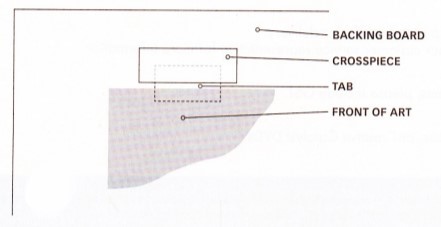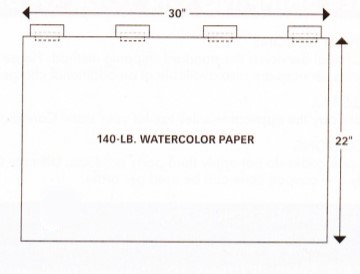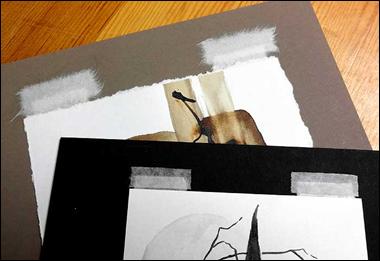
Q: I was recently introduced to the double T-hinge. Could you explain more fully how that works?
A: A T-hinge consists of two rectangles, a tab which attaches to the art and a larger crosspiece that holds it to a backing board (diagram 1). The larger crosspiece should be sized to fully cover the exposed tab attached to the upper back of the art. The crosspieces are only there for additional support and shall never come in contact with the art, nor fully cover the entire exposed tab. There should remain a small space—about ⅛"—between the edge of the art and the support crosspiece that has no adhesive and is not attached to the backing.

T-hinges are used when a window mat will be covering a painting and additionally supporting the hinged art around all sides. Hinges are designed to be the weakest link in the framing package, allowing it to break in that unglued portion rather than tear the art in the event of a fallen frame or damage during transport. That unglued area is also where the art would be cut free from the backing if reframed, thus discarding the pasted crossbar with the old backing.
I assume "double T-hinge" is referring to the use of two hinges across the top. The actual number of required hinges will be determined by the width and weight of the art being suspended. Two hinges is the absolute minimum for a vertical 15x22" lightweight Ingres drawing paper, but a 22x30" full sheet 140# watercolor paper would require three for a vertical and four hinges for a horizontal presentation. They should be about 1½" wide and ½" high, with the long side attached to the art. If only two hinges are used they should be placed just inside the far edge of the art, with additional hinges dividing the remaining distance with equal placement between.

Preservation hinges—as used by Library of Congress—are made by tearing strips from long fiber, handmade Japanese papers such as Mulberry (heavyweight), Kizukishi (medium weight), Tosa tengujo and Kozogami tsuru (lightweight) and cooked starch paste of wheat or rice powder. Commercial hinge products are sold as gummed water activated and pressure-sensitive tapes but these should never be used with original or irreplaceable art. The gummed linen tapes are far too strong, inflexible, have sharp edges and the adhesive leaves residue and stain art over time. Pressure-sensitive tapes are also long term damaging and the adhesive is impossible to remove.
Lineco Hayaku is a long fiber hinge product with a dry, neutral pH, water activated, starch adhesive on one side capable of holding up to 15 pounds of weight when properly mounted. By sizing the hinge and laying it onto a wet paper towel the water can wick into the hinge not disturbing the adhesive. Once moist it can be applied to the art.
 Photo 1
Photo 1
Top image illustrates torn Japanese paper T-hinges mounted using cooked wheat starch paste. They are pasted to the back of the art then pasted with a crosstab to the backing. Bottom sample shows the same technique using commercial Lineco Hayaku water activated hinge material sold by the roll. Originals would normally be hinged to white backing board. Dark boards are used for illustration.
Q: Many watercolor artists enter exhibitions across the country and around the world. Having a painting come loose from mounting tape is a common problem, as the heat and cold affects the adhesive power of the tape. Also, mulberry hinges aren't strong enough to support a full-sheet painting in shipping. Can you offer a solution?
A: As mentioned in the previous answer for the most part commercial hinge tapes should be avoided for original art. Though they are fine for replaceable items, open edition imagery and in some cases water base giclée inks that cannot tolerate moisture. It is generally not the heat and moisture that allows tape to fail but the original application technique. With a gummed water activated tape enough moisture must be applied to fully activate the adhesive, but not so much as to actually wipe it off. Not enough moisture doesn't make it sticky enough to soak into the art paper, too much can cockle the paper, soak through and/or thin out the adhesive too much.
Pressure-sensitive tapes require burnishing of the adhesive into the art paper to activate a greater initial bond. Burnishing is the aggressive rubbing of the tape surface with a polished smooth bone or similar tool. When any tape is applied to a surface a simple quick rub with your hand may only activate the adhesive about 25%. Even with a burnishing tool the adhesive is only activated about 80% with the final bond occurring after it fully cures, which is best under a weight.
Heat and cold can contribute to bond failure because of the expansion and contraction of the art paper vs. the same expansion and contraction of the tape carrier, the paper or film the adhesive has been applied to. So once again it isn't actually failure of the adhesive but rather the method of application.
Also mentioned in the previous answer 100% kozo, handmade, long fiber Japanese mulberry paper hinges are extremely strong, but machine made less expensive mulberry paper has chopped fibers and is not. When a wet line is drawn on high quality Japanese mulberry paper the two parts should pull apart with long fibrous attachments. Those fibers are what gives it the strength. All that said the technique for the application of starch paste must also be done correctly to create a strong bond for the hinges.
The correct number of real Japanese mulberry hinges will easily hold a full 22x30" sheet. In fact a horizontal 4'x8' sheet of handmade cast paper was hinged with only eight jumbo hinges—a variation on the T-hinge—across the long side for display within an acrylic box for the National Gallery. That said…keep in mind the hinge is designed to be the weakest link and should break before the art tears. If the hinges peeled off they were improperly installed, if torn they saved the art from damage.
An alternative method is not to hinge matted art but to use edge strips or corner pockets instead. Both are preservation methods of mounting that are noninvasive, reversible and give good support on all four sides for shipping.
Edge strips are commercially available as Art Saversa 1-ply bristol board which is folded to channel the edge of the art and Lineco Mounting Stripsas 1-ply rag faced with clear Mylar. Both have double-sided adhesive and release liner for application, but no adhesive touches the art.
Corner pockets may be purchased in assorted sizes, weights and configurations of polyester film. They should only be used for art strong enough to tolerate corner stress, but when all four corners of a 22x30" 140# watercolor paper are supported with 3" cutout corners the original will not fall from its mount during shipping.
END
Copyright © 2014 Chris A Paschke
Chris A. Paschke, CPF GCF, Tehachapi CA, received Certified Picture Framer (CPF) status 1986 from Professional Picture Framers Association (PPFA) and Guild Commended Framer (GCF) status 1997 from Fine Art Trade Guild (FATG) UK. She was awarded the PPFA Award of Distinction 2008, the PPFA Award of Recognition and Innovation 2010, and PMA Distinguished Service Award 2012 for her ongoing research on framing giclées and digitals. Author of The Mounting And Laminating Handbook, Third Edition, she has been mounting specialist, educator, author and columnist to the framing industry for more than 25 years.
For more articles on mounting basics look under the mounting section in Articles by Subject.
Additional information on all types of mounting is found in:
The Mounting and Laminating Handbook, Second Edition, 2002,
The Mounting And Laminating Handbook, Third Edition, 2008 and
Creative Mounting, Wrapping, And Laminating, 2000 will teach you everything you need to know about getting the most from your dry mount equipment and materials as an innovative frame designer.
All books are available from Designs Ink Publishing through this website.
Chris A Paschke, CPF GCF
Designs Ink
Designs Ink Publishing
785 Tucker Road, Suite G-183
Tehachapi, CA 93561
P 661-821-2188
chris@designsinkart.com